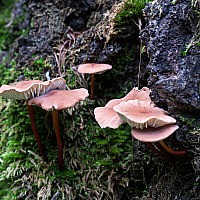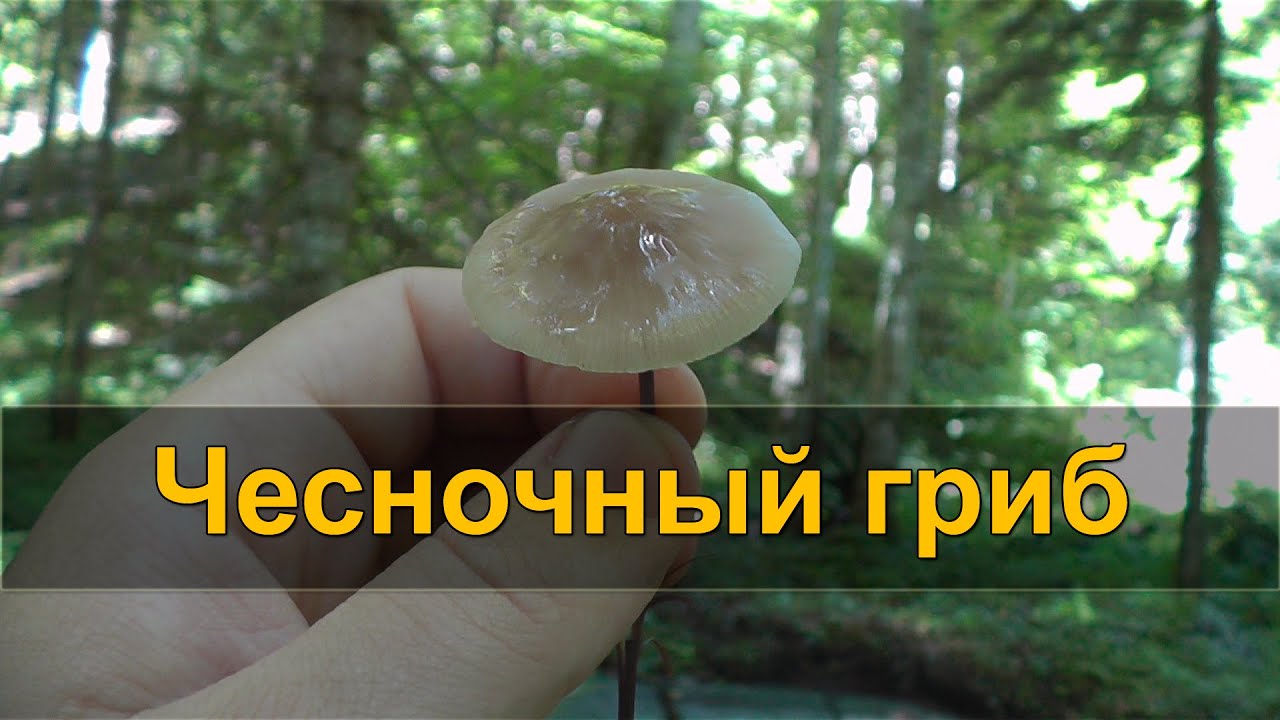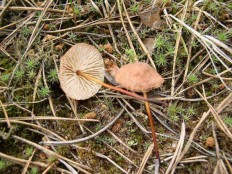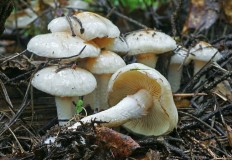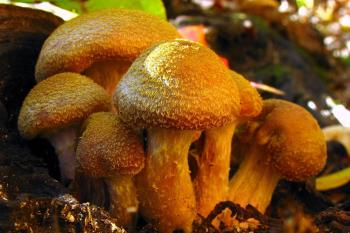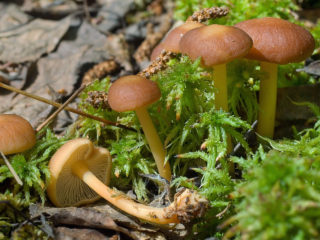Large garlic (Mycetinis alliaceus) what mushrooms look like, where and how they grow, edible or not
Large garlic: photo and description
| Name: | Large garlic |
| Latin name: | Mycetinis alliaceus |
| View: | Edible |
| Synonyms: | Large bream, Agaricus alliaceus, Chamaeceras alliaceus, Mycena alliacea, Agaricus dolinensis, Marasmius alliaceus, Marasmius schoenopus |
| Systematics: |
|
Large garlic (the second name is large non-fungus) belongs to the genus Garlic, it is considered a variation of the mushrooms of the non-fungus family. It is rare. Most avid mushroom pickers unfairly bypass it, believing that it is inedible.

This type is used to prepare culinary dishes, and in dried form it serves as a fragrant seasoning that emphasizes the taste of various products.
How does a big garlic look
The large garlic (Mycetinis alliaceus) belongs to the all-season species, which arises one of the first, starting fruiting in the spring. Occurs in forests, fields, on packed grass and first thawed patches.
The garlic aroma is characteristic of this lamellar mushroom, for which it was named. Grows in large groups.
Description of the hat
The diameter of the hat is 1 - 6.5 cm. It has an ideal surface and is translucent along the edges. The shape of the cap of young specimens is bell-shaped, with growth it becomes prostrate.
The plates are permanent, not fused with the surface of the leg. The color of the hats can vary from reddish brown to dark yellow in color. In the very center of the cap, the color is more intense.
The color of the plates is grayish or pink-white. The fragile pulp, when rubbed, has a garlic smell. The surface of the cap is rather dry.
Leg description
Stem elastic, smooth, with slight pubescence at the very base. The leg length can reach 6-15 cm, and the diameter is only 3 mm. The color is dark, usually from brown to black with a specific shine.
The leg is in the form of a cylinder, sometimes flattened. The structure is dense. The color of the flesh is the same for both the stem and the cap.
Eat a mushroom or not
Garlic non-fungus is an edible mushroom. It is used boiled and fried, boiled in advance for a short time. With a long boil, the smell is lost. Fried with potatoes, used to make sauces. The taste is well appreciated, in which the mushroom smell is made up for by the pronounced garlic.
In the Western European kitchen room, the big garlic is a real delicacy. They are harvested for the future by drying. Dried mushrooms retain their own properties for 5 years. Before use, it is enough to hold the non-oil pot in the water mass for 5 - 10 minutes.
Dried garlic powder is used to make sauces and as a fragrant seasoning in a wide variety of dishes. It is also considered to be a very good natural preservative to increase the shelf life of foods.
Raw materials are not subject to decay, do not deteriorate when properly dried and stored. Negnium has antiviral, antifungal and antibacterial properties. It is used in pharmacology for the production of medicines.
Where and how it grows
The fungus grows in colonies, distributed in deciduous forests, in fields in European territory. Prefers rotten branches, dead wood, stumps, caked grasses. The species is thermophilic, therefore it is less common in the regions of the north and the middle lane. It occurs more often in the southern part of Russia.
Doubles and their differences
The large garlic can be confused with the species of this family:
- Common garlic is an edible mushroom. It stands out for its small size and red-brown leg with a flat surface.
- The oak garlic is a rare species, conditionally edible.It is distinguished by the structure of the cap, the color of the stem and its structure (in the oak garlic it is pubescent). Growing, it paints the substrate around itself in a white-yellow color. Grows in oak plantings, oak foliage.
Conclusion
Large garlic is a real delicacy from which you can prepare culinary masterpieces. In addition, the mushroom has beneficial elements and helps to make foods longer shelf life. In cooking, hats are used, because the legs of the non-iron pot have an elastic consistency. After cooking, they become overly harsh.
Places of distribution of common garlic, description of the mushroom

On a quiet forest hunt, you can get not only abundant material for assorted mushrooms, but also ready-made seasoning for it. So, the small mushroom common garlic fully provides the appropriate smell, which is especially appropriate in spicy and spicy mushroom dishes.
Description
Common Garlic (Marasmius scorodonius) or Common Garlic is a miniature edible mushroom that has the following distinctive features:
- a smooth cap in the early stages of growth has a convex shape, a small tubercle is noticeable in the central part, later it becomes prostrate, with a diameter of 1 to 3 cm.In dry weather, it is painted in yellowish-brown, ocher or fawn tones, and in wet weather it becomes brown with pinkish shade, while slightly furrowed edges always remain lighter than the central part;
- adhered to the peduncle or loose plates wavy, unequal length, frequent or medium frequency, creamy white, yellowish;
- whitish spores;
- a rigid hollow leg has a length of 0.5 to 6 cm with a thickness of 1 to 3 mm, cartilaginous, shiny, pubescent in the lower part. Yellowish-orange color towards the base darkens to red-brown, almost black;
- the pulp is pale, very thin, with a strong smell of garlic and mushroom taste.
Places of distribution and period of fruiting
The fruit bodies of the common garlic grow on rather dry clay and sandy soils of coniferous, deciduous and mixed forests.
They settle on fallen leaves and needles, on stumps, fallen bark and branches, on heather stalks. In humid weather, the characteristic garlic odor increases, so that the colonies of this fungus can be recognized literally "by smell".
The fruiting season begins in mid-summer and ends by mid-autumn.
Similar types of differences from them
Common garlic is similar to edible species similar in shape and color:
- meadow honey (Marasmius oreades) is found in the same places, painted in brownish shades, but it does not have the slightest sign of garlic smell;
- the large garlic (Mycetinis alliaceus) is much larger - the diameter of its cap reaches 5 cm. This variety inhabits the fallen branches and foliage of beeches, is common in European deciduous forests;
- oak garlic (Mycetinis querceus) is a rare species that grows on dead oak leaves.
Primary processing and preparation
The common garlic is an edible species and does not require boiling before eating. This mushroom seasoning is added to roasts, soups, marinades, sauces, both fresh and dried. When dried, the garlic smell becomes stronger.
Miniature common garlic is a forest spice prepared by nature itself. A knowledgeable collector can only use it to add a new flavor of aroma to mushroom cooking.
Common garlic - a mushroom with a garlic smell

Common garlic is a mushroom of the family Negniychnikovye, genus Garlic. It is an edible mushroom. It is also called ordinary non-nippers.
The Latin name of the mushroom is Marasmius scorodonius.
Description of common garlic
The hat of the garlic is usually convex in shape, over time it becomes flat-spread. Its diameter is small - from 1 to 3 centimeters. The color of the cap is yellow-brown, slightly buffy, and eventually becomes fawn. It is lighter on the edges. The hat is small and dry, the skin is dense and rough.
There are small grooves along the edges of the cap. In fully ripe garlic plants, the caps become bell-shaped with very thin edges. Over time, the cap becomes wider, and a small depression appears in the central part.When it rains, the hat absorbs moisture and becomes meaty-red, and in dry weather, its color fades.
The pulp is pale with a pronounced smell of garlic, which, when dried, becomes even stronger, which is why the name of the mushroom came about. The plates are wavy, convex, of different lengths, located far from each other. They grow to the base of the stem. Their color is whitish or pale red. Spore white powder.
Reddish brown leg colors, while its lower part is lighter. The surface of the leg is shiny and cartilaginous. It is hollow inside.
Distribution of common garlic
These mushrooms are found in various types of forests. They grow in forest floor, choosing dry places. Common garlic plants prefer clay and sandy soils. Most often they are found in large groups. Fruiting from July to October.
Fungal colonies are easily identified by the smell of garlic emitted by the mushroom bodies. On cloudy and rainy days, this smell becomes stronger.
Edibility of common garlic
These are edible mushrooms. They can be used boiled, fried, pickled and dried. Ordinary garlic plants are also well suited for making hot spices. After boiling, the characteristic garlic smell disappears, but when dried, on the contrary, it intensifies.
The similarity of common garlic with other mushrooms
Common garlic can be confused with meadow grass, which grows on branches and fallen needles, but does not smell like garlic.
Other mushrooms of this genus
The blood-headed firebrand is one of the rarest mushrooms in the world. Its peculiarity is that it glows in the dark. There is very little information about these mushrooms.
Bloodheads have a graceful appearance - their legs are very thin, and their domed caps are deep red in color. There are longitudinal stripes on the top of the caps, which are located symmetrically in relation to each other. The leg is darker. These mushrooms grow on fallen or old trees. There is no information about their toxicity, but they are classified as inedible species.
The stamen grass is an inedible mushroom. His hat is initially convex, but with age it becomes prostrate.
The stamen grass bears fruit from June to September. These mushrooms settle on small branches of fallen trees. They are often found among the sand dunes, in the wastelands.
They grow in large colonies, which consist of several dozen specimens.
There is no information about the toxicity of these mushrooms, it is possible that they do not contain toxic substances, but they are classified as inedible species and are not eaten due to the unpleasant smell of the pulp.
Common Garlic mushroom: super supplement for 37 dishes

From Latin - Marasmius scorodonius. Edible mushroom of the 4th category, used fresh (for additions to soups and sauces, after boiling the smell disappears), if dried, the smell increases. Occurs from June to mid-October in coniferous and mixed forests. They love to appear in families after the rain.
Marasmius scorodonius
Walking through the forest, you may not even see it, but you can easily smell its garlic smell. Experienced mushroom pickers collect it with scissors. Thus, cutting off the leg and collecting only the caps. When dried, it almost does not decrease in size.
Mushroom gourmets love this species very much for such an unusual taste.
But here the point is different, it sometimes happens that you cannot find a large family, and therefore, if you managed to find 5-7 pieces, then the hats can be dried and used as an addition to the dish - this is something amazing!
Photo - Paul Kli
Any dishes become a delicacy if you add common garlic to them. High school chefs know about this secret and use it for its intended purpose.Even if you fry ordinary potatoes, adding this mushroom to the dish becomes unique. Take note of this.
At the first collection, I advise you to study this mushroom in detail so as not to confuse it with other species. Smell is one of the criteria.
Common garlic Is no longer food, but a natural aromatic additive (mushroom is a spice).
Photo - Stephen Buchan
Thanks for reading to the end!subscribe to the channeland don't forget about likes
You may also be interested in:
How to Distinguish Mushrooms: False Chanterelle from Real ChanterelleRow Purple - a mushroom that kills cancer cells15 ways how and what to wipe a ** poo in the woods
Common Garlic (Mycetinis scorodonius) - Mushrooms of Siberia

Current title
| Index Fungorum | Mycetinis scorodonius (Fr.) A.W. Wilson & Desjardin |
| MycoBank | Mycetinis scorodonius (Fries) A.W. Wilson & Desjardin |
Systematic position
Fungi, Basidiomycota, Agaricomycetes, Agaricales, Omphalotaceae, Mycetinis
Etymology of the species epithet
Scorodonius, a, um, garlic. From σκόροδον (scorodon) n, garlic + ius, a, um (possession of a trait).
Synonyms
- Agaricus scorodonius Fr., Observ. mycol. (Havniae) 1:29 (1815)
- Marasmius scorodonius (Fr.) Fr., Anteckn. Sver. Ätl. Svamp .: 53 (1836)
- Chamaeceras scorodenius (Fr.) Kuntze, Revis. gen. pl. (Leipzig) 3 (2): 457 (1898)
- Gymnopus scorodonius (Fr.) J.L. Mata & R.H. Petersen, in Mata, Hughes & Petersen, Mycoscience 45 (3): 221 (2004)
Other names: Garlic Negnium.
M. scorodonius in the field is easily identified by its general reddish-brown coloration, bare smooth stalk, and a bright garlic odor that can often be seen before the mushroom itself.
Habit
Fruit body: Cap and stem (agaricoid)
Hat
The hat is 12-30 mm in diameter, at first hemispherical, rounded, then opens to a convex one with a slightly depressed center and an irregularly wavy edge, hygrophane, brown, pinkish-brown, buffy in wet weather, when dry it is pale brown, light buffy or almost white, the edge is always slightly lighter than the center. The surface is smooth, in old fruiting bodies - radially ribbed.
The plates are adherent or almost free, white.
Leg
Stem (15) 40 - 60 mm long, 0.5 - 1.5 (3) mm in diameter, cylindrical, smooth, often tapering downward, light brown in the upper part, dark brown, almost black in the lower part.
Pulp
The pulp is thin, of the same color as the surface, with a strong smell and taste of garlic.
Microscopy
Spores (7.0) 8.0 - 10 (11) × 3.5 - 4.0 (5.0) μm, Q = 2.2, cylindrical.
Basidia 28 - 42 × 7.0 - 9.0 μm, clavate, 4-, rarely 2-spore.
Pileipellis consists of clavate elements (5.0) 20 - 42 (58) × (4.0) 8.0 - 24 (35) μm, with yellow-brown walls.
Buckles are found in all fabrics.
Ecology and distribution
It grows singly and in groups on various substrates: needles, small litter and moss-covered bark at the base of living trees, both coniferous and deciduous, on herbaceous remains.
In the vicinity of the Novosibirsk Academgorodok, it is rather rare, on the mossy bases of the trunks of large birches, sometimes on mossy stumps. According to Perova and Gorbunova, it is common and ubiquitous; it grows on litter, which does not agree with our observations.
The following species are indicated as substrates: fir (Abies), maple (Acer), wormwood (Artemisia campestris), heather (Calluna), eucalyptus (Eucalyptus), crowberry (Empetrum), European beech (Fagus sylvatica), fescue (Festuca) , Norway spruce (Picea abies), Scots pine (Pinus sylvestris), oak (Quercus), rhododendron (Rhododendron), raspberries (Rubus), brittle willow (Salix fragilis), hemlock (Tsuga).
Fruiting
July - September.
The divisions correspond to the decades of the month.
Nutritional properties
Edible
Used as a condiment.
Similar species
Large garlic (Mycetinis alliaceus) is distinguished by its large size and pubescent black leg.
Distribution in Western Siberia
Everywhere in aspen-fir, pine and pine-birch forests.
Related materials
- Antonin V., Noordeloos N. E. A monograph of marasmioid and collybioid fungi in Europe. - Eching: IHW-VERLAG, 2010 .-- 480 p. - P. 400–404.
- Bas C., Kuyper Th. W., Noordeloos M. E., Vellinga E. C. Flora Agaricina Neerlandica. Critical monographs on families of agarics and boleti occurring in the Netherlands. Vol. 3. Tricholomataceae. - Rotterdam - Brookfield: A. A. Balkema, 1995 .-- 183 p. - P. 151-152.
- Perova N.V., Gorbunova I.A.Macromycetes of the south of Western Siberia. - Novosibirsk: Publishing house of the Siberian branch of the Russian Academy of Sciences, 2001. - 158 p. - S. 84.
- Desjardin D. E. Culture morphology of Marasmius species. // Sydowia. - 1990. - V. 42. - P. 17–87.
Link to this page for prints
Ageev D.V., Bulonkova T.M. Common garlic (Mycetinis scorodonius) - Mushrooms of Siberia URL: https://mycology.su/mycetinis-scorodonius.html (date of access: 27.11.2019).
by reference
Common garlic
 Bio-encyclopediaMushrooms:Common garlic occurs in groups from June-July to October in coniferous and deciduous forests, on their edges, fallen branches, brushwood, needles and near stumps of coniferous trees after rains.
Bio-encyclopediaMushrooms:Common garlic occurs in groups from June-July to October in coniferous and deciduous forests, on their edges, fallen branches, brushwood, needles and near stumps of coniferous trees after rains.
It got its name for the pungent garlic smell, which intensifies on the eve of a cloudy rainy day. This piquant trait makes it easier to find colonies of this delicious mushroom.
The cap is dry, miniature, a quarter of a match thick, up to 2 cm in diameter, rarely up to 5 cm, cap-like, straightens to flat with age, pale yellowish or brownish in color, with radial stripes. The plates are white, narrow, frequent, adherent. The pulp is brownish, dense.
Leg 3-6 cm high, dark brown or reddish-brown at the bottom, lighter at the cap, 0.2-0.3 cm thick, hollow, shiny.
For a skinny, frail appearance, phenologist D. Zuev affectionately called these mushrooms "marasmus" (their scientific name is "marasmius scorodenius"), and journalist and avid mushroom picker V.
Kovtun gave the garlic man the following description: the leg is a thin carnation, the cap is pale yellow or whitish, as if cut out of paper. True, the leg, although thin, is strong, tough, but the cap can be crushed between the fingers. It has a very thick garlic smell, but not as sharp as natural garlic, but softer, more delicate and seemingly sweetish.
The writer V. Soloukhin says that he once saw that many tiny mushrooms were growing around an old spruce.
Mechanically pinched one, rubbed it between his fingers and suddenly felt a distinct strong smell of fresh garlic. “It was scary to put mushrooms in the pan,” he says.
- It seemed that they would all dry up, burn out, and nothing would remain. But, contrary to expectations, it turned out to be a very spicy and fragrant dish ”.
Garlic is an edible mushroom. Belongs to the IV category. It is consumed fried. Used to prepare hot spicy seasonings. The piquant smell of the mushroom remains during drying, and disappears during boiling.
But during one of the dinner parties, pleased with the guests' praise for a magnificent mushroom dish, Napoleon ordered the quartermaster who had dined with the guests to introduce the cook. "What is this extraordinary tasty dish?" The emperor asked the cook.
"I beg your pardon, but the guests ate with the mushroom sauce ... your old fencing glove." It is possible that this is where the French proverb came from, that you can eat the sole with mushroom sauce.
Literature
When using the materials of the site, it is necessary to put active links to this site, visible to users and search robots.
Common Garlic - Mycetinis-scorodonius
Written by Nikolay Budnik and Elena Meck.
Common garlic is rarely found in our forests. It has no independent value, but is used as a seasoning. No wonder the mushroom is called the garlic - it smells very strongly of garlic. But this is not a primitive straightforward smell - it has notes of onions, pepper and other spices. You can even look for a garlic by its smell - you can immediately smell where these mushrooms grow. The mushroom is very thin and small. To get it even for sauce, you need to work hard.
But the game is worth the candle - the dishes with the garlic are simply fragrant.
Common garlic grows on fallen needles at the base of coniferous tree trunks. We also met him in the abandoned fields near the lonely pine trees. The mushroom can be seen from July to September. This is a very small mushroom - the diameter of a very thin cap reaches 3-4 cm.

1. Garlic is a very small mushroom.

2. It is not immediately noticeable among the grass.

3. The cap of the garlic is rather dry, very thin, as if made of paper.

4. She is leathery, flesh-colored.

5. The hat in the middle is slightly darker.

6. The edges of the cap quickly become wavy, ribbed, and cracked.

7. The plates are rather rare and thin. They are white or slightly creamy.

8. In old mushrooms, the edges are bent upwards, so the plates become visible from the outside.

9. The leg of a garlic plant looks like a thin red-brown wire. You can immediately recognize the mushroom by it.

10. The leg is hollow inside. At the bottom, it is often covered with a white fluffy coating.

eleven.The flesh of the mushroom is very thin. It is whitish in color. The pulp has a mushroom flavor and a strong garlic smell.
Common garlic, Marasmius scorodonius
Hat: Small in size (1-3 cm in diameter, very rarely more), from hemispherical to flat, completely prostrate; the edges of the cap in adult mushrooms are often uneven. The surface is hygrophane, the color is irregular, highly variable depending on humidity and other growing conditions, from gray-white to creamy brown. The flesh of the cap is rather thin (however, the plates are not translucent), light, without a definite taste and with a very strong, even in dried specimens, the smell of garlic.
Hymenophore: The plates are white, wide, sparse, branching, free or semi-free.
Spore powder: White.
Leg: Very thin (rarely thicker than 1.5 mm), relatively high (up to 6 cm), dark-colored (red, brown), cartilaginous texture, looks like a blade of grass.
Spreading: Common garlic bears fruit throughout almost the entire mushroom season, from June to October, in forests and glades, often settling on dead wood and litter. In warm, humid weather, it appears in huge colonies, which, however, are quite difficult to distinguish from the height of human growth.
Similar species: The very strong odor of garlic makes it easy to distinguish Marasmius scorodonius from other small non-fungi, and even more so mycene; the only representative of the genus Marasmius, which has similar “odor characteristics”, the big garlic (Marasmius alliaceus) is really big and does not look like a common garlic except for the smell.
Edibility: According to numerous reports, Marasmius scorodonius is used as a condiment, since the garlic flavor persists even after heat treatment. The sources do not report how much time it takes to recruit the garlic plants to prepare the seasoning.
Author's notes: Science knows a lot of odorless mushrooms, but here - the rarest precedent of smell without a mushroom
And I do not even hint at the well-known “bodily insufficiency” of the common garlic - formally, at least when there is a mushroom, it can produce a smell from it, and it is not so important that the intensity of the garlic amber does not at all correspond to the weight and size characteristics of the fruit body of Marasmius scorodonius. But it also happens that in a damp meadow, or somewhere in wet bushes, a mighty garlic spirit falls on a person, almost squeezing into the soil, and around - not a single fruit calf! In this case, you can think a lot about the Forest Master, who, they say, prefers wild garlic to the entire forest pharmacy, and about the gourmet mushroom pickers who have just passed here (but why are they, bastards, not seen or heard ?!), and about olfactory hallucinations, which is a completely unusable symptom
but looking a little closer, you notice thin white filaments of mycelium on the black soil and you realize that there are, theoretically, mushrooms here. The smell just came first. And the army of petty stubborn garlic farmers will soon catch up with him.



















